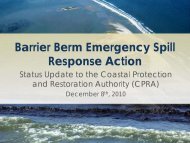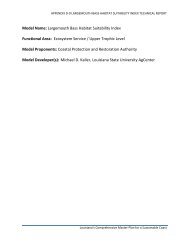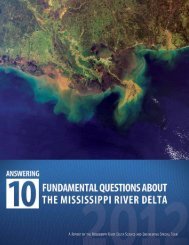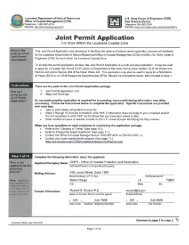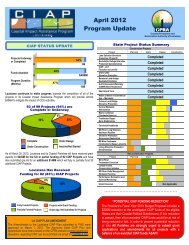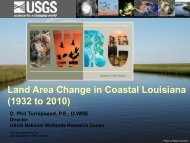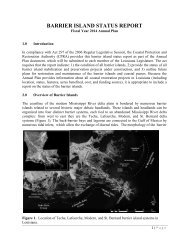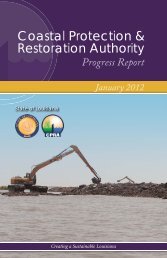- Page 1 and 2: Louisiana Coastal Impact Assistance
- Page 3 and 4: de~criptions including scope. budge
- Page 5 and 6: TABLE OF CONTENTS I. INTRODUCTION
- Page 7 and 8: 1. Enhanced Management of Mississip
- Page 9 and 10: 5. Marsh Creation with Dredged Mate
- Page 11 and 12: River long distance sediment pipeli
- Page 13 and 14: Cameron Parish: Iberia Parish: Jeff
- Page 15 and 16: St. Martin Parish: St. Mary Parish:
- Page 17 and 18: On January 12, 2006, Will Norman of
- Page 19 and 20: On February 22, 2006, Greg Grandy,
- Page 21 and 22: On June 20, 2006, LDNR hosted a pub
- Page 23 and 24: On February 28, 2007, Greg Grandy o
- Page 25 and 26: On August 6, 2009, the addition of
- Page 27 and 28: ) an LCA Science and Technology Pro
- Page 29 and 30: VI. PLAN IMPLEMENTATION PROGRAM Sta
- Page 31: Plan, the LCA Plan, and the work of
- Page 35 and 36: The Assumption Parish CIAP point of
- Page 37 and 38: Calcasieu Parish CIAP Plan Implemen
- Page 39 and 40: F. A Description of the Major Activ
- Page 41 and 42: the CIAP Plan to best achieve Camer
- Page 43 and 44: Iberia Parish CIAP Plan Implementat
- Page 45 and 46: F. A Description of the Major Activ
- Page 47 and 48: The CIAP point of contact for Jeffe
- Page 49 and 50: E. How Jefferson Parish plans to en
- Page 51 and 52: Lafourche Parish and the State of L
- Page 53 and 54: Livingston Parish CIAP Plan Impleme
- Page 55 and 56: F. A Description of the Major Activ
- Page 57 and 58: The CIAP point of contact for Orlea
- Page 59 and 60: Plaquemines Parish CIAP Plan Implem
- Page 61 and 62: F. A Description of the Major Activ
- Page 63 and 64: C. The St. Bernard Parish public pa
- Page 65 and 66: Since one of the St. Charles Parish
- Page 67 and 68: St. James Parish CIAP Plan Implemen
- Page 69 and 70: D. The St. James Parish decision-ma
- Page 71 and 72: Implementation of individual CIAP p
- Page 73 and 74: St. Martin Parish CIAP Plan Impleme
- Page 75 and 76: D. The St. Martin Parish decision-m
- Page 77 and 78: B. How St. Mary Parish will manage,
- Page 79 and 80: F. A Description of the Major Activ
- Page 81 and 82: C. The St. Tammany Parish public pa
- Page 83 and 84:
Tangipahoa Parish CIAP Implementati
- Page 85 and 86:
G. An Estimate of Funds, that will
- Page 87 and 88:
D The Terrebonne Parish decision-ma
- Page 89 and 90:
Since one of the Vermilion Parish C
- Page 91 and 92:
G. An Estimate of Funds, that will
- Page 93 and 94:
o $ 1,020,000.00 Port of Iberia Bri
- Page 95 and 96:
St. John the Baptist Parish o $ 2,0
- Page 97 and 98:
Jefferson Parish o $ 4,000,000.00 B
- Page 99 and 100:
VIII. PROPOSED PROJECT DESCRIPTIONS
- Page 101 and 102:
2) Project Title: Bayou Lamoque Flo
- Page 103 and 104:
Project Justification: Addressing t
- Page 105 and 106:
The Bayou Bienvenue-Central Wetland
- Page 107 and 108:
For land acquired in fee title thro
- Page 109 and 110:
Total CIAP Funds Proposed: $7,230,2
- Page 111 and 112:
8) Project Title: Mississippi River
- Page 113 and 114:
Description and Location of Project
- Page 115 and 116:
11) Project Title: State of Louisia
- Page 117 and 118:
13) Project Title: Mississippi Rive
- Page 119 and 120:
14) Project Title: Living Shoreline
- Page 121 and 122:
15) Project Title: Atchafalaya Long
- Page 123 and 124:
Project Justification: The involved
- Page 125 and 126:
Project Type: Authorized Use 1 Proj
- Page 127 and 128:
The proposed project is very import
- Page 129 and 130:
5) Project Title: Fringe Marsh Repa
- Page 131 and 132:
The CIAP funding for this project f
- Page 133 and 134:
Positive environmental benefits to
- Page 135 and 136:
8) Project Title: Mississippi River
- Page 137 and 138:
Total CIAP Funds Proposed: $837,114
- Page 139 and 140:
Description and Location of Project
- Page 141 and 142:
12) Project Title: Port of Iberia B
- Page 143 and 144:
14) Project Title: Project Name: Vi
- Page 145 and 146:
15) Project Title: West Caminada He
- Page 147 and 148:
Total CIAP Funds Proposed: $9,351,0
- Page 149 and 150:
Parish-Funded Tier One Projects Ass
- Page 151 and 152:
Infrastructure Funds Proposed: $0 F
- Page 153 and 154:
Total CIAP Funds Proposed: $2,000,0
- Page 155 and 156:
management and will reduce the amou
- Page 157 and 158:
Total CIAP Funds Proposed: $1,339,8
- Page 159 and 160:
Cameron Parish 1) Project Title: Ba
- Page 161 and 162:
Hydrologic restoration is a local s
- Page 163 and 164:
Description and Location of Project
- Page 165 and 166:
Total CIAP Funds Proposed: $1,868,7
- Page 167 and 168:
8) Project Title: Dreary Island Res
- Page 169 and 170:
Project Cost Share: None Duration:
- Page 171 and 172:
3) Project Title: Vermilion Bay Sho
- Page 173 and 174:
5) Project Title: Port of Iberia Br
- Page 175 and 176:
The back-bay side of Grand Isle is
- Page 177 and 178:
Project Justification: The project
- Page 179 and 180:
Project Justification: The project
- Page 181 and 182:
Project Justification: The water co
- Page 183 and 184:
Lafourche Parish 1) Project Title:
- Page 185 and 186:
Since 2000, the Barataria-Terrebonn
- Page 187 and 188:
2) Project Title: Northwest Little
- Page 189 and 190:
Livingston Parish 1) Project Title:
- Page 191 and 192:
Description and Location of Project
- Page 193 and 194:
Total CIAP Funds Proposed: $175,000
- Page 195 and 196:
the adjacent marshes. That reductio
- Page 197 and 198:
Description and Location of Project
- Page 199 and 200:
Coast 2050: Common Coastwide Strate
- Page 201 and 202:
Total CIAP Funds Proposed: $2,409,7
- Page 203 and 204:
St. James Parish 1) Project Title:
- Page 205 and 206:
The tract of land will allow a siph
- Page 207 and 208:
accretion through increased organic
- Page 209 and 210:
St. James Parish will pay for the m
- Page 211 and 212:
Total CIAP Funds Proposed: $265,100
- Page 213 and 214:
St. James Parish has already hired
- Page 215 and 216:
The site is dominated primarily by
- Page 217 and 218:
suspended solids, wastewater applic
- Page 219 and 220:
St. Martin Parish 1) Project Title:
- Page 221 and 222:
Total CIAP Funds Proposed: $3,701,4
- Page 223 and 224:
Project Justification: Although lim
- Page 225 and 226:
St. Mary Parish 1) Project Title: B
- Page 227 and 228:
Description and Location of Project
- Page 229 and 230:
Description and Location of Project
- Page 231 and 232:
Total CIAP Funds Proposed: $1,152,7
- Page 233 and 234:
Project Justification: At the reque
- Page 235 and 236:
Project Justification: Mr. Haywood
- Page 237 and 238:
Description and Location of Project
- Page 239 and 240:
Proposed Project Features: Project
- Page 241 and 242:
Terrebonne Parish No Parish-Funded
- Page 243 and 244:
Project Justification: The proposed
- Page 245 and 246:
Description and Location of Project
- Page 247 and 248:
Description and Location of Project
- Page 249 and 250:
9) Project Title: Weeks Bay/Commerc
- Page 251 and 252:
State Tier Two Projects 1) Project
- Page 253 and 254:
Wetland wastewater treatment will r
- Page 255 and 256:
Where feasible, these projects stan
- Page 257 and 258:
4) Project Title: Lake Pontchartrai
- Page 259 and 260:
6) Project Title: Point Au Fer/Lake
- Page 261 and 262:
Project Cost Share: None Duration:
- Page 263 and 264:
Total CIAP Funds Proposed: $875,000
- Page 265 and 266:
One approach to the problem include
- Page 267 and 268:
Project Type: Authorized Use 1 Proj
- Page 269 and 270:
to variations in the ratio of the d
- Page 271 and 272:
Contact Information: John Boudreaux
- Page 273 and 274:
acres of the lake’s shoreline at
- Page 275 and 276:
Gapping the western section of Whit
- Page 277 and 278:
2) Project Title: Reclamation of Sa
- Page 279 and 280:
sediment laden water to increase ma
- Page 281 and 282:
2) Project Title: Artificial Reef i
- Page 283 and 284:
Total CIAP Funds Proposed: $440,277
- Page 285 and 286:
Project Justification: The Port of
- Page 287 and 288:
Project Justification: This project
- Page 289 and 290:
The project is consistent with the
- Page 291 and 292:
Project Cost Share: None Duration:
- Page 293 and 294:
5) Project Title: Tidal Restriction
- Page 295 and 296:
Additionally, the historical width
- Page 297 and 298:
Project Justification: Hurricane Ka
- Page 299 and 300:
Description and Location of Project
- Page 301 and 302:
2) Project Title: Lake Pontchartrai
- Page 303 and 304:
Plaquemines Parish 1) Project Title
- Page 305 and 306:
3) Project Title: Grand Bayou Ridge
- Page 307 and 308:
Project Justification: St. Charles
- Page 309 and 310:
Since humans moved into the marsh a
- Page 311 and 312:
The proposed project would consist
- Page 313 and 314:
Project Type: Authorized Use 1 Proj
- Page 315 and 316:
protection, flood control, control
- Page 317 and 318:
Project Justification: Approximatel
- Page 319 and 320:
aseline site conditions in the proj
- Page 321 and 322:
dredging 30º 3’ 32” N, 91º 20
- Page 323 and 324:
This project will conserve, restore
- Page 325 and 326:
St. Tammany Parish 1) Project Title
- Page 327 and 328:
The initial phase of the project wi
- Page 329 and 330:
to waterfowl and other animals. Bas
- Page 331 and 332:
Coast 2050, the State’s blueprint
- Page 333 and 334:
The overall project goals are to fo
- Page 335 and 336:
3) Project Title: North Lost Lake M
- Page 337 and 338:
4) Project Title: Shoreline Protect
- Page 339 and 340:
Description and Location of Project
- Page 341 and 342:
7) Project Title: Houma Navigation
- Page 343 and 344:
The project will help to mitigate O
- Page 345 and 346:
2) Project Title: LA 167 Extension
- Page 347 and 348:
4) Project Title: Northeast White L
- Page 349 and 350:
6) Project Title: Chenier au Tigre
- Page 351 and 352:
8) Project Title: Hydrologic Restor



